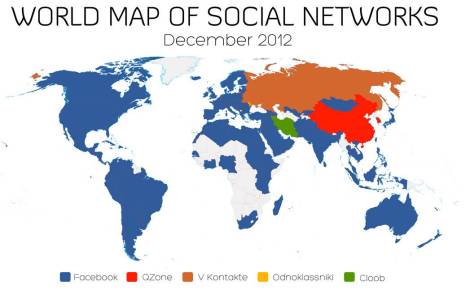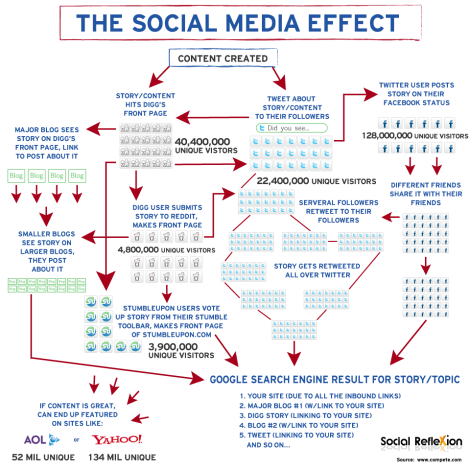There’s something incredible about the way the world is such a vast landscape, yet so united and interconnected by social media.
Whether everyone admits to it or not, we are all bloggers in a literal sense. We are all keeping diaries of our most intimate moments to share with the world. Okay, so all is only a tiny exaggeration, especially when you take a look at these stats showing the number of top 10 social media networks used by Australians:
1. Facebook – 12,000,000 monthly Australian users
2. YouTube – 11,750,000 UAVs
3. WordPress.com – 5,100,000
4. Tumblr – 4,200,000
4. LinkedIn – 3,400,000
6. Blogspot – 3,200,000
7. Twitter – 2,167,849 Active Australian Users
8. Instagram – 1,469,000 Active Australian Users
9. Flickr – 840,000
10. TripAdvisor – 830,000
Yes, that means we are not simply limited to sharing our information with our close friends and families. The meteoric expansion of social networking sites, which have shifted to a more open network model, allows for strangers to witness your wedding, your birthday, your child’s first day at school. And while that sounds scary, that’s what users want. Demand drives innovation.

The dark blue across the globe demonstrates Facebook’s global social networking hegemony, disrupted mostly by China and Russia’s more protected states.
You see, to ‘blog’ is a now an established and accepted colloquialism for the verb ‘to ‘weblog’, meaning to log information on the web. I’d be surprised if the majority of social media users considered themselves ‘bloggers’ because many understand one to be an opinion writer or amateur journalist. However, a wide variety of blogging tools exist that many may be unsuspecting of:
Uploading videos to YouTube is logging an event on the internet.
Posting a picture on Facebook, tagging your friends in the picture and setting a location is recording a particular event in your life – on the internet.
Replying to Prime Minister Kevin Rudd on Twitter with what you think of his automotive industry boosts is a way of publicising your opinion – on the internet.
Updating your skills and experience on LinkedIn for potential employers to see is an example of logging personal information – ON THE INTERNET!
Virginia Gewin suggests updating your personal information on the Internet plays a crucial role in self-portrayal online, using the example of scientist profiles to illustrate just how important it is for information to be current.
While she even discusses the simplicity of being able to monitor such a vast, open online environment for mentions of your name, she goes ahead to warn against what she labels as the oft-confused distinction between Facebook friend and colleague:
“Scientists should consider whether they prefer a ‘filter’ or ‘firewall’ approach — whether they place a barrier between their personal and professional lives or carefully craft a mix of the two.”
Below is a short video that I watched in my first year of university in 2010. It has always stuck in my mind whenever people question how significant social media has become in our lives and further reiterates how ‘blogging’ has become a natural extension of our everyday lives.
Interestingly, Boyd & Ellison (2007) define social network sites as:
“web-based services that allow individuals to
-
(1) construct a public or semi-public profile within a bounded system;
-
(2) articulate a list of other users with whom they share a connection, and
-
(3) view and traverse their list of connections and those made by others within the system. The nature and nomenclature of these connections may vary from site to site.”
All three characteristics are key aspects of a popular, functioning social network system. This definition was coined in 2007, which was a relatively early stage for social networks. While the first social network site was launched around 1997 (think SixDegrees.com), the concept didn’t really kick off until 2003 or so. The main boundary that prevented sites capturing audiences (users, consumers) on a global scale, in a way that Facebook and YouTube do nowadays, was the way in which users were restricted from viewing other profiles that weren’t a direct connection within their network. Once people started becoming ‘Friends’, ‘Fans’ and ‘Followers’ of other profiles, social media sought a new direction. It allowed networks to expand significantly, creating new relationships from all ends of the earth.
The formula to the success of these social network sites is simple:
Personalisation of profiles leads to common interests which can create new connections. And nowadays, this is becoming more and more important to include in social media strategy.
This allows for new publics to be created. So it’s not just about people seeing what you’re going to do today. It’s about what you’re going to do today and can we share this experience together in some way? People from countries all across the globe can be part of the same group and actively engage with each other using social network sites.
“Care2 helps activists meet, Couchsurfing connects travelers to people with couches, and MyChurch joins Christian churches and their members.” (Boyd & Ellison, 2007)
This all sounds well and great, but with great power comes great responsibility. The removal of physical, geographic, lingual boundaries also means access to private information can be sought by criminals, or simply by other users with bad intentions.
Online scams and child grooming are two examples of ways in which users are still not experienced in protecting themselves against criminals. Privacy is also another major concern as people’s information becomes more and more valuable to marketers who want to know exactly what your interests/spending habits are. The simplicity of sharing and downloading music, movies and television shows is creating a massive burden on the entertainment industry, which is losing its more traditional sources of revenue thanks to torrent sites such as The Pirate Bay.
And, of course, as is the case with any dramatic uptake, social media can be monetised. The below diagram is a great example of the ways businesses can harness social media for their commercial advantage. In essence, the more people who talk about your brand, the more traffic you can drive to your site. And the more traffic you drive, the more advertisers are willing to spend so their product is exposed to your audience.
In the coming weeks, I’ll be writing about exactly how online and mobile media has affected our daily rituals – all the good AND all the bad.
So stick around.
REFERENCES:
boyd, d & Ellison, N 2007, ‘Social network sites: Definition, history, and scholarship’, Journal of Computer-Mediated Communication, 13, pp. 210-230.
Gewin, V 2011, ‘Self-reflection, online’, Nature, Vol. 471, accessible at <www.nature.com/naturejobs/2011/110331/pdf/nj7340-667a.pdf>.
‘Social Media Statistics Australia – September 2013’, Frank Media, October 1, accessible at <http://frankmedia.com.au/2013/10/01/social-media-statistics-australia-september-2013/>.

